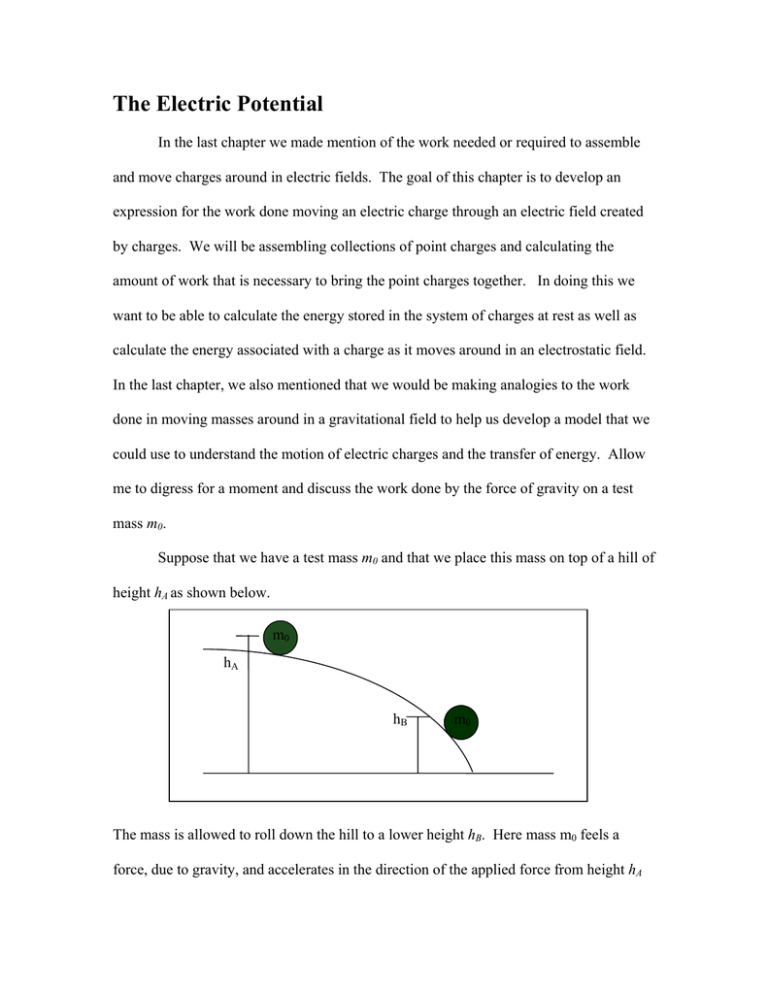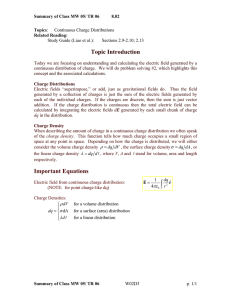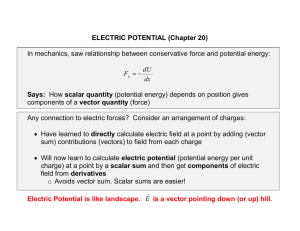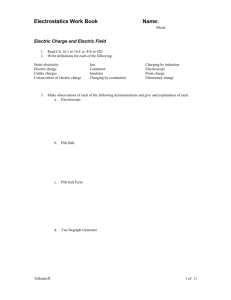The Electric Potential
advertisement

The Electric Potential In the last chapter we made mention of the work needed or required to assemble and move charges around in electric fields. The goal of this chapter is to develop an expression for the work done moving an electric charge through an electric field created by charges. We will be assembling collections of point charges and calculating the amount of work that is necessary to bring the point charges together. In doing this we want to be able to calculate the energy stored in the system of charges at rest as well as calculate the energy associated with a charge as it moves around in an electrostatic field. In the last chapter, we also mentioned that we would be making analogies to the work done in moving masses around in a gravitational field to help us develop a model that we could use to understand the motion of electric charges and the transfer of energy. Allow me to digress for a moment and discuss the work done by the force of gravity on a test mass m0. Suppose that we have a test mass m0 and that we place this mass on top of a hill of height hA as shown below. m0 hA hB m0 The mass is allowed to roll down the hill to a lower height hB. Here mass m0 feels a force, due to gravity, and accelerates in the direction of the applied force from height hA to height hB. Work is done on mass m0 by the force of gravity and the test mass m0 accelerates from a region of higher gravitational potential to a region of lower gravitational potential. I have not yet defined what a gravitational potential is, but I am going to use this term and will define its meaning shortly. Using the definition of work r r we write W AB = F ⋅ d = mgh A − mghB = GPE A − GPE B , where we define the gravitational potential energy at an arbitrary point in the gravitational field to be GPE = mgh. The work done in moving the mass m0 from the point at height hA the point at height hB is positive, meaning that the system (the gravitational force due to the mass of the Earth and m0) did the work moving the mass m0 from hA to hB. The mass m0 has its potential energy converted into kinetic energy as it accelerates from this region of higher gravitational potential energy to the region of lower gravitational potential energy. In addition, we said that the mass m0 accelerates from a region of higher gravitational potential to a region of lower gravitational potential. Let us now define what we mean by the gravitational potential. We see that the amount of gravitational work done depends on the test mass we use. Let us remove the reference to the test mass and define the gravitational potential as the work done per unit test mass, m0, or GP = W = gh . Thus given the mass m0 above, m0 accelerates from a region of high m0 gravitational potential (gha) to a region of lower gravitational potential (ghb). In other words, picking the mass up and placing it at a height hA, we have stored energy in the system as potential energy. There is a potential for the mass to convert this stored energy into another form, namely kinetic energy, if work is done by the force of gravity on the mass m0. This expression for the gravitational potential is written with the assumption that the zero of the potential is taken where the height is zero. Here we have defined and used the gravitational potential only after being able to calculate an expression for the work done by the gravitational field on the mass m0. Now let’s turn our attention to a test charge q0 in an electrostatic field. By analogy with the force of gravity, given the electric field shown below, a charge q0 will feel a force, due to q0’s interaction with the electric field of Q, and accelerate in the direction of the applied force from a region of higher electric potential to a region of lower electric potential. rB rA Q q0 r E In this situation, work will be done on q0 by the electric field and the electrostatic work done can be written as WAB = EPEA − EPEB . Here we do not know what the actual expression for the electric potential energy, EPE, at this point, but we will derive an expression shortly. However, we can define, in analogy with gravity, the electric potential, V, as the work done per unit test charge V = W because we want to be able to q0 not have to worry about what charge q0 we are moving. Notice that electric potentials are scalar quantities with units of Joules per Coulomb. Now we need to actually evaluate the electrostatic work done on q0, as q0 accelerates from a point located at a distance ra from Q to a region rb, where rb > ra. To calculate the electrostatic work done, we need to use a more general definition for the work done by the electrostatic force on q0, since the electrostatic force is a position dependant force. In other words we cannot simply multiply the force by the displacement of q0. Calculating the work for the position dependant electrostatic force we find r r rB kQq0 ⎡1 1⎤ ⎡1 1⎤ = ∫ F ⋅ dr = ∫ 2 dr = − kQq0 ⎢ − ⎥ = kQq0 ⎢ − ⎥ . Recalling the definition ⎣ rA rB ⎦ ⎣ rB rA ⎦ rA rA r rB W AB of the electric potential given above, we can therefore write for the expression for the electric potential due to a point charge Q as V = W kQ , so that the work done = qo r is WAB = q(VA − VB ) = q∆VAB . Here we have defined our zero of the potential to be when q0 is at an infinite distance from Q. With caution, notice that this definition for the work done is written in terms of the difference between where the charge starts and where the charge ends up, which is not always the way the electrostatic work is written by textbook authors. Most physicists prefer differences in quantities to be written in final minus initial form. Thus you may also see the electrostatic work written as W AB = −q(VB − V A ) = −q∆VBA . In addition, we can also write the electric potential energy from our expression for the work done on q0 by the electric field due to Q as EPE = q0V = k q0 Q . More r generally, a positive charge q will accelerate from a region of high electric potential to a region of lower electric potential, losing potential energy while gaining kinetic energy. A negative charge q will accelerate from a region of lower electric potential to a region of higher electric potential, losing potential energy and gaining kinetic energy. Having defined the electric potential we can now assign to each radius surrounding a charge Q, a surface of constant potential, called an equipotential surface. For a single point charge Q, the shells are concentric spheres centered on Q and extending outward towards infinity as shown below. In addition, some of the electric field vectors for the point charge Q is also displayed. A relation can be formulated between the magnitude of the electric field and the variation of the electric potential with distance. From the diagram below we can see that the electric field vector points along decreasing electric potentials and the electric field is everywhere perpendicular to the equipotential surfaces surrounding Q. VC rC VB rB VA rA Q r E The relation between the magnitude of the electric field and the electric potential can be written as E = − dV , in units of volts per meter, or Newtons per Coulomb. In dr addition we can show that the electric field has to also be perpendicular to the equipotential surfaces. To show this, assume that the electric field did not cross the equipotential surface perpendicular to that surface, but rather at some angle θ, measure with respect to the surface. Since the electric field is a vector, we can break the electric field up into components and we will have one perpendicular to the equipotential surface and one parallel to the equipotential surface. Since there is a component of the electric field parallel to the equipotential surface, any charge q on the surface will feel a force parallel to the surface and will accelerate in the direction of the applied force. Thus, a non-zero amount of work will be done on q by the electric force (and the electric field parallel to the surface.) However, as we will see in the example below, example #2 specifically, that on an equipotential surface, the work done on the charge is zero. So how do we rectify this ambiguity? We fix the problem, by removing the component of the electric field parallel to the equipotential surface, thus leaving only a component perpendicular to the surface. Now let’s try to apply what we have developed to solve some problems involving work and the electric potential. Example #1 – What is the electric potential at distances 0.5 m, 1.0 m and 5.0 m from a 10 µC point charge? Solution – We use the definition of the electric potential due to a point charge. For the given distances we find in order: Q V0.5 = k = 9 ×109 r Q V1.0 = k = 9 × 109 r Q V5.0 = k = 9 ×109 r 10 × 10 −6 C 5 × = 1.80 × 105 Nm C = 1.80 × 10 0.5m 10 ×10 −6 C Nm 2 × = 9.00 ×10 4 CJ C2 1.0m 10 × 10 −6 C Nm 2 × = 1.80 × 10 4 CJ C2 5.0m Nm 2 C2 J C Example #2 – How much work is done on a charge q0 = 1µC if the charge is moved around the equipotential surface located at 5.0m from a 10 µC point charge? Solution – We’ll use the potential calculated in Example #1 above for a distance of 5.0 m from a 10 µC point charge and calculate the work done using this value. The work done is given as W AB = q0 (V A − VB ) = 1× 10 −6 C × (1.8 × 10 4 J C − 1.8 × 10 4 J C ) = 0 J , as it should be on an equipotential surface. In other words, it costs neither me nor the system work to move a charge around on an equipotential surface, because the potential is a constant on the equipotential surface. Example #3 – Moving a charge from one equipotential surface to another. a. How much work is done in Example #1 if a 1 µC charge is moved from the equipotential surface located at 1.0m to the equipotential surface located at 5.0 m? b. How much work is done if I reverse the process and move the charge from 5.0 m to 1.0 m? Solution – a. The work done is given as ( W AB = q 0 (V A − V B ) = 1 × 10 −6 C × 1.8 × 10 5 J C − 1.8 × 10 4 J C ) = +0.162 J . The system does positive work on the charge and the charge accelerates away from Q. b. If the process is reversed, meaning that I move the charge from a location of 5.0 m to a location of 1.0 m, the work done is W AB = q 0 (V A − V B ) = 1 × 10 −6 C × (1.8 × 10 4 J C − 1.8 × 10 5 J C ) = −0.162 J . The negative sign here is a reflection of the fact that the charge will not naturally move toward Q, due to the charges having the same sign. To make q0 move toward Q, I have to do work, and this costs me energy. The energy that I lost is stored in the system as potential energy. Example #4 – The assembly of point charges at the corners of a square. How much work does it take to assemble four positive point charges, brought in from infinity, one at a time, at the corners of a square with sides of length a? Solution – We’ll assemble the charges starting at the origin and proceeding counterclockwise until all charges are placed on the corners of the square. The net work is going to be the sum of all of the work required to assemble the charges one at a time. The work to place the first charge is W1 = q∆V AB = q (V∞ − Vorigin ) = 0 J . To place the second charge, at the lower right corner of the square, at a distance a away ⎛ Q⎞ from the first charge, the work is W2 = q∆VAB = q (V∞ − Va ) = − q⎜ k ⎟ . To place the ⎝ a⎠ third charge, at the upper right corner of the square, at a distance 2a from the first charge and at a distance a from the second charge ( is W3 = q∆V AB = q (V∞ − Va ) + q V∞ − V 2a Q ⎞ kqQ ⎛ 2⎞ ⎜1 − ⎟. ⎟=− ⎜ a ⎝ 2 ⎟⎠ 2a ⎠ ) = −q⎛⎜ k Qa ⎞⎟ − q⎛⎜ k ⎝ ⎠ ⎝ The work required to place the last charge at the upper left corner of the square is ( W4 = q∆V AB = q (V∞ − Va ) + q (V∞ − Va ) + q V∞ − V 2a ) = −2q⎛⎜ k Qa ⎞⎟ − q⎛⎜ k ⎝ ⎠ ⎝ Q ⎞ kqQ ⎛ 2 ⎞. ⎜2 − ⎟ ⎟=− ⎜ a ⎝ 2 ⎟⎠ 2a ⎠ Therefore the net work is the sum of all of the individual works needed to assemble the charges. Thus we have Wnet = ∑ Wi = − ( ) kqQ 4− 2 . a Example #5 – The electric potential due to two point charges. What is the total electric potential at a point P located 4m along the positive x-axis for the collection of point charges shown below? Q1 has a value of -6 µC while Q2 has a value of 2 µC. Solution – The total electric potential is the sum of the potentials due to the two point charges as shown on the diagram. Since the potential is a scalar quantity, we add algebraically the potentials created from each point charge. y Q1 3m P Q2 x 4m Thus the electric potential at point P is Vtotal Q Q = V+ + V− = k + + k − = 9 ×109 r+ r− Nm 2 C2 ⎛ 2 ×10 −6 C 6 ×10 −6 C ⎞ ⎟⎟ = −6.32 ×103V . × ⎜⎜ − 5m ⎠ ⎝ 4m Example #6 – The work done to move place a charge in a potential created by point charges. How much work does it take to bring in a 3 µC point charge from infinity and place it in the potential created at point P of Example #5 due to the point charges Q1 and Q2? Solution – The work done is the product of the charge that you want to move and the difference in potential from where the charge starts to where the charge ends up. Therefore evaluating the work we find W = q∆V = q(V∞ − VP ) = 3 × 10 −6 C × (0 − (− 6.3 × 103V )) = 18.9 × 10 −3 J = 18.9mJ . The positive sign of the work means that the system will do the work. If I wanted to remove the charge from this location, I would have to do work on the charge equal to the negative of the work done by the system. Example #7 – The electric potential due to an electric dipole. What is the total electric potential at a point P located along the positive x-axis electric dipole on the x-axis centered on the origin? Solution – Given the diagram below, let each point charge be located at a distance a from the origin along the x-axis. The electric potential is the algebraic sum of the potentials due to each charge at point P y P -Q x +Q Defining the distance x to be measured from the origin to the point P, we have V P= V+ q + V− q = kq kq 1 ⎞ 2kqa ⎛ 1 − = kq⎜ − . In the event that the ⎟= 2 2 r+ r− ⎝ x−a x+a⎠ x −a point P lies very far away from the point charges, we can use x >> a to evaluate the electric potential due to the dipole as V P≈ 2kqa . x2 As another example let’s combine the idea of electric potential, electric field and the electrostatic force. Example #8 – Putting together electric forces, fields and potentials. What are the net electrostatic force, net electrostatic field, and the electric potential for a test charge q = 1.28x10-18 C located at the origin between two positive charges Q = 2 µC located equidistant from q at 0.8 m? Solution – To calculate the net electrostatic force at the origin we choose the coordinate system shown below and draw the forces that act on q. We find for the net force Fnet = + k Qq Qq − k 2 = 0 N in magnitude. 2 a a r r Fnet The net electrostatic field is given from the force E net = = 0 CN . q The electric potential at the origin is the algebraic sum of the potentials at the origin due to the two point charges located a distance a away. Therefore we have Vtotal = Vleft + Q + Vright + Q = + k Q Q Q + k = 2k = 2 × 9 × 109 a a a r Fq,Right + Q q r Fq,Left + Q Nm 2 C2 × 2 × 10 −6 C = 45 × 103V = 45kV . 0.8m x Up to now, we’ve calculated electric potentials for collections of point charges and we have also calculated the work done in moving charges around in electric fields. As a practical application, let’s look at how a particle accelerator works and to do this we’ll use the ideas of electric force, electric field, the electric potential and energies associated with point charges. Example #9 – The electron volt as a unit of energy. When dealing with elementary charges and atoms, we routinely encounter very small values when computing energies. Physicists have a short hand way of writing these tiny energies and this shorthand way is called the electron volt. Consider a proton being accelerated through a difference in potential of one volt. How much work is done? Solution – The work done accelerating the proton (with charge e) through a difference in potential of 1.0 V is W = q∆V = 1e × 1V = 1eV , or one electron-volt, labeled as eV. However, the magnitude of the charge of the proton is the same as that of the electron, or 1.6x10-19 C, so and energy of 1 eV corresponds to 1.6x10-19 J. Now we have a more convenient way of expressing very small values of energies in terms of electron volts rather than Joules. Example #10 Rutherford Backscattering Spectroscopy An alpha particle (which contains 2 protons and 2 neutrons) passes through the region of electron orbits in a gold atom, moving directly toward the gold nucleus, which has 79 protons and 118 neutrons. The alpha particle slows and then comes to a momentary rest, at a center-to-center separation r = 9.23x10-15m before it begins to move back along its original path. (This technique is called Rutherford Backscattering Spectroscopy and the alpha particles are usually accelerated using a particle accelerator.) a) What was the initial kinetic energy of the alpha particle when it was initially far away, external to the gold atom? (Hint: Assume that the gold atom does not move since it is much more massive than the alpha particle.) b) Given the kinetic energy in part a, through what potential difference was the alpha particle accelerated? c) How much work was done on the alpha particle in accelerating it through the potential difference in part b? d) The Union College Pelletron particle accelerator 1.1 MV tandem electrostatic accelerator. This accelerator takes alpha particles and accelerates them two times in succession (hence the tandem) and then the alpha particles are allowed to interact with the nucleus of a gold atom. Supposing that the alpha particles reach an energy of 3.3 MeV using the Pelletron accelerator, what will the center-to-center separation of the alpha particle and the gold nucleus? Solution a. By conservation of energy we have the PE acquired by the alpha particle equal to the KE lost as the alpha particle is brought to rest by the repulsive electrostatic force that exists between the two positively charges objects. Therefore we have KE = PE = k Q1Q2 = 9 ×109 r Nm 2 C2 ⎛ 2e × 79e ⎞ −12 ⎜ ⎟ = 3.94 × 10 J = 24.6 MeV . −15 ⎝ 9.23 × 10 m ⎠ b. By the work kinetic energy theorem, the work done accelerating the alpha particle is equal to its change in kinetic energy. Thus KE = q∆V → 3.94 × 10 −12 J = (2e )∆V → ∆V = 3.94 × 10 −12 J = 1.23 × 10 7 V = 12.3MV 2 ×1.6 × 10 −19 C c. From part b, the work done is the change in kinetic energy, 3.94 × 10 −19 J . d. The distance of closest approach is given by the conversion of the alpha particle’s kinetic energy into potential energy. Q1Q2 r QQ 2e × 79e ⎞ 2 ⎛ −14 = k 1 2 = 9 × 109 Nm ⎜ ⎟ = 6.90 × 10 m −13 C2 KE 5 . 28 × 10 J ⎝ ⎠ KE = PE → 3.3MeV = 5.28 ×10 −13 J = k rnew This is about a factor of 8x farther away.





